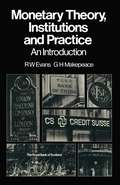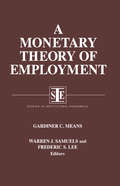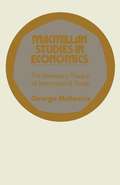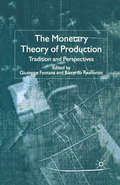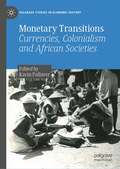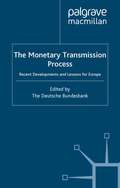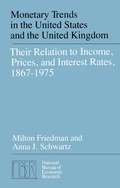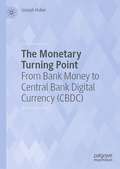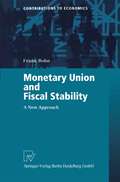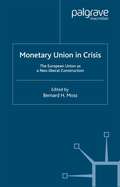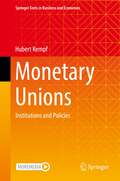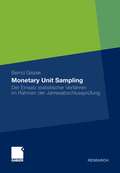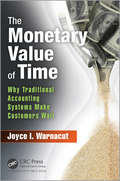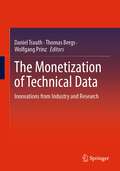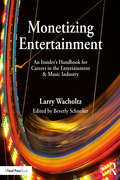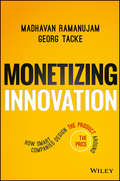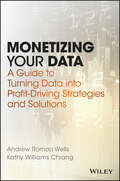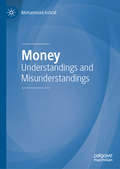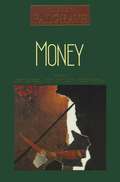- Table View
- List View
A Monetary Theory of Employment
by Gardiner C. Means Warren J. Samuels Lily Xiao LeePresents the author's alternative monetary theory and macroeconomics to both the quality theory and Keynes's work. This text reveals Means's view of the economic processes in the real world, and the state of monetary and macroeconomics theory in the mid-1940s.
A Monetary Theory of Employment
by Gardiner C. Means Warren J. Samuels Lily Xiao LeePresents the author's alternative monetary theory and macroeconomics to both the quality theory and Keynes's work. This text reveals Means's view of the economic processes in the real world, and the state of monetary and macroeconomics theory in the mid-1940s.
The Monetary Theory of Production: Tradition and Perspectives
by G. Fontana R. RealfonzoThis volume examines the theory of monetary circulation and applies it to several modern issues including unemployment, inflation, distribution and economic policies. It will provide a valuable contribution to the field of monetary economics, and in particular, its development of non-neoclassical approaches to monetary economics.
Monetary Transitions: Currencies, Colonialism and African Societies (Palgrave Studies in Economic History)
by Karin PallaverThis book uses money as a lens through which to analyze the social and economic impact of colonialism on African societies and institutions. It is the first book to address the monetary history of the colonial period in a comprehensive way, covering several areas of the continent and different periods, with the ultimate aim of understanding the long-term impact of colonial monetary policies on African societies. While grounding an understanding of money in terms of its circulation, acceptance and impact, this book shows first and foremost how the monetary systems that resulted from the imposition of colonial rule on African societies were not a replacement of the old currency systems with entirely new ones, but were rather the result of the convergence of different orders of value and monetary practices. By putting histories of people using money at the heart of the story, and connecting them to larger imperial policies, the volume provides a new and fresh perspective on the history of the establishment of colonial rule in Africa. This book is the result of a collaborative and interdisciplinary research project that has received funding by the Gerda Henkel Foundation. The contributors are both junior and senior scholars, based at universities in Europe, Africa, Asia and the US, who are all specialists on the history of money in Africa. It will appeal to an international audience of scholars and educators interested in African Studies and History, Economic History, Imperial and Colonial History, Development Studies, Monetary Studies.
The Monetary Transmission Process: Recent Developments and Lessons for Europe
by D. BundesbankThe start of the European monetary union gave additional impetus to the lively debate on the effects of monetary policy and the appropriate strategy for central banks. This book collects papers and comments by leading academics and central bankers such as O.Issing, M.King, B.McCallum, A.Meltzer, L.Svensson and H.Tietmeyer. The volume examines methodological questions, the actual role played by the financial sectors and labour markets in implementing monetary policy in Europe, and the likely future developments in these areas.
Monetary Trends in the United States and the United Kingdom: Their Relations to Income, Prices, and Interest Rates (National Bureau of Economic Research Monograph)
by Milton Friedman Anna J. SchwartzThe special task of this book is to present a statistical and theoretical analysis of the relation between the quantity of money and other key economic magnitudes over periods longer than those dominated by cyclical fluctuations-hence the term trends in the title. This book is not restricted to the United States but includes comparable data for the United Kingdom.
The Monetary Turning Point: From Bank Money to Central Bank Digital Currency (CBDC)
by Joseph HuberThe monetary system is at a turning point. The question is no longer if, but how soon countries will roll out a Central Bank Digital Currency (CBDC). This book discusses the recomposition of the money supply from the present bank money regime to a monetary system determined by CBDC. As the book sets out, the future of money is going to be digital and sovereign. Nonetheless, the relationship between the various types of money is competitive rather than being the peaceful coexistence that was officially envisaged. CBDC competes with the incumbent bank money as well as with private cryptocurrencies that are challenging both central-bank money as well as bank money. For technological and political reasons, bank money will not be able to emulate the superior properties of sovereign digital tokens. Uncovered and unwarranted cryptocurrencies, too, will not stand the competition in the long run. The shifts in the monetary system are changing the role of central banks in the interplay of monetary, fiscal and private-creditary functions and open up improved options for monetary policy. The book will be of interest to academics, researchers, and policymakers in monetary and financial economics, and digital currencies.
Monetary Union and Fiscal Stability: A New Approach (Contributions to Economics)
by Frank BohnThis book addresses the macroeconomic implications of a country's transition to a monetary union. By using a dynamic multi-country simulation model, it is possible to pinpoint a monetary union, and repercussions produced by fiscal retrenchment policies. Interest and exchange rate effects could only be captured once a new approach including innovations in the solution methodology had been developed. Not only can we draw lessons for newly joining members to the EMU or to any other monetary union, but the analysis also implicitly offers a new explanation for the weak Euro in the first half of 1999.
Monetary Union in Crisis: The European Union as a Neo-Liberal Construction
by B. MossThis volume presents a radical reinterpretation of the European Community or Union as a neo-liberal construction. It was neo-liberal rather than classically liberal because it was designed and used as an external instrument to weaken the interventionist welfare state that protected working people and strengthened the hand of labor. It was founded on the vision of a free market untrammelled by public intervention and worked to ensure competition, sound money and profitability against the inflationary force of workers and unions and the welfare state. Monetary union in particular restored profitability but produced slow growth, mass unemployment, and insecurity and came under challenge, most dramatically in France, by working people from below. This view is substantiated by an economically based study of member-state performance and complemented by a series of national studies on the monetarist turn by leading scholars.
Monetary Unions: Institutions and Policies (Springer Texts in Business and Economics)
by Hubert KempfThis textbook explains the notion of monetary union, highlighting the key concepts, procedures, and challenges involved. The book is organized in three parts. In the first part, the reader learns about monetary issues, like definitions and typology of monetary unions, rationale of monetary unions, monetary policy, monetary institutional matters. The second part is devoted to fiscal matters and the interplay between fiscal and monetary policies, such as deficits, transfers, public debt sustainability issues, fiscal policy, policy mix. The last part focuses on other distinct but related issues, necessary to complete the union: banking and fiscal unions, structural adjustments in a monetary union. It ends with a chapter on the fate of monetary unions: how they develop, mature and sometimes dissolve.The book addresses students at undergraduate and graduate level, interested in a better understanding of international macroeconomics and monetary unions, as well as policy-makers, practitioners and economists in central banks, ministries of economics, economic institutions and banks.
Monetary Unit Sampling: Der Einsatz statistischer Verfahren im Rahmen der Jahresabschlussprüfung
by Bernd GiezekBernd Giezek stellt anschaulich die Grundlagen von Monetary Unit Sampling als statistisches Standardverfahren für Jahresabschlussprüfungen vor und zeigt aktuelle Weiterentwicklungen auf.
The Monetary Value of Time: Why Traditional Accounting Systems Make Customers Wait
by Joyce I. WarnacutAlthough there are numerous books on alternative accounting methods, such as Lean accounting, none focus on the impact of time and how accounting practices can be modified to acknowledge the power of time. This book addresses this need.The Monetary Value of Time: Why Traditional Accounting Systems Make Customers Wait presents a framework for assessing the value of time in terms of organizational strategy and competitive advantage. The framework presented will enable organizations to develop consistent measures and ensure that their cost accounting system isn’t motivating behaviors that add to lead time and make customers wait.The framework outlined in this book is relevant to the managerial and cost accounting practices in today’s manufacturing environment, which is increasingly moving away from mass production to custom manufacturing. The framework is supported by high-level metrics, which are reinforced by operational metrics. This is supported by accounting data that recognize the value of time. Pricing models that incorporate the concept of time are presented. The book provides many examples of how the use of standard costing and traditional accounting practices in a high-mix/low-volume production environment can produce contradictory or even inaccurate results that form the basis for poor decisions that may actually move your organization farther from its objectives.The book arms readers with options for overcoming traditional barriers by applying direct costs at an item level, while applying overheads at a macro or value stream level. For example, while GAAP requires overhead application for inventory valuation, a common misconception is that overhead must be applied at an item level. In fact, overhead can be absorbed by one journal entry. Demonstrating the linkages between time-based accounting data and meaningful business metrics that drive bottom line results, the book presents methods and metrics that have been successfully applied by the author in manufacturing environments.
The Monetary Value of Time: Why Traditional Accounting Systems Make Customers Wait
by Joyce I. WarnacutAlthough there are numerous books on alternative accounting methods, such as Lean accounting, none focus on the impact of time and how accounting practices can be modified to acknowledge the power of time. This book addresses this need.The Monetary Value of Time: Why Traditional Accounting Systems Make Customers Wait presents a framework for assessing the value of time in terms of organizational strategy and competitive advantage. The framework presented will enable organizations to develop consistent measures and ensure that their cost accounting system isn’t motivating behaviors that add to lead time and make customers wait.The framework outlined in this book is relevant to the managerial and cost accounting practices in today’s manufacturing environment, which is increasingly moving away from mass production to custom manufacturing. The framework is supported by high-level metrics, which are reinforced by operational metrics. This is supported by accounting data that recognize the value of time. Pricing models that incorporate the concept of time are presented. The book provides many examples of how the use of standard costing and traditional accounting practices in a high-mix/low-volume production environment can produce contradictory or even inaccurate results that form the basis for poor decisions that may actually move your organization farther from its objectives.The book arms readers with options for overcoming traditional barriers by applying direct costs at an item level, while applying overheads at a macro or value stream level. For example, while GAAP requires overhead application for inventory valuation, a common misconception is that overhead must be applied at an item level. In fact, overhead can be absorbed by one journal entry. Demonstrating the linkages between time-based accounting data and meaningful business metrics that drive bottom line results, the book presents methods and metrics that have been successfully applied by the author in manufacturing environments.
The Monetization of Technical Data: Innovations from Industry and Research
by Daniel Trauth Thomas Bergs Wolfgang PrinzThe monetization of data is a very young topic, for which there are only very few case studies. There is a lack of strategy or concept that shows decision-makers the way into the monetization of data, especially those who have discovered or are threatened by the digital transformation or Industry 4.0. Because machine data is usually unstructured and not usable without domain knowledge/metadata, the monetization of machine data has an as yet unquantifiable potential. In order to make this potential tangible, this work describes not only contributions from science, but also practical examples from industry. Based on different examples from various industries, the reader can already become part of a future data economy today. Values and benefits are described in detail. The translation was done with the help of artificial intelligence. A subsequent human revision was done primarily in terms of content.
Monetizing Entertainment: An Insider's Handbook for Careers in the Entertainment & Music Industry
by Larry WacholtzMonetizing Entertainment: An Insider's Handbook for Careers in the Entertainment & Music Industry offers a thorough, guided exploration of the current state of the industry, with an emphasis on trends in copyright, digital streaming, and practical advice for developing a career as an artist, technician, or industry executive. This book investigates a variety of topics within the entertainment and music industry, ranging from traditional and emerging business models to intellectual property rights to the creative destruction happening currently. The book strategically outlines the existing gaps that make being successful as an artist a dynamic interaction between creativity and business. This book includes the following: An overview of the creative destruction process that has destroyed some of the old business models and created a number of career options. A look at innovative, entrepreneurial career options. A step-by-step examination for both creative and business professionals of the administrative and financial structures of the industry. Detailed analysis of trends and topics shaping the current entertainment and music industry drawn from insiders' perspectives and other contemporary resources. An accompanying website (www.routledge.com/cw/wacholtz), hosting case studies, videos, data, infographics, and blog posts on business models, is the perfect companion to this authoritative resource.
Monetizing Entertainment: An Insider's Handbook for Careers in the Entertainment & Music Industry
by Larry WacholtzMonetizing Entertainment: An Insider's Handbook for Careers in the Entertainment & Music Industry offers a thorough, guided exploration of the current state of the industry, with an emphasis on trends in copyright, digital streaming, and practical advice for developing a career as an artist, technician, or industry executive. This book investigates a variety of topics within the entertainment and music industry, ranging from traditional and emerging business models to intellectual property rights to the creative destruction happening currently. The book strategically outlines the existing gaps that make being successful as an artist a dynamic interaction between creativity and business. This book includes the following: An overview of the creative destruction process that has destroyed some of the old business models and created a number of career options. A look at innovative, entrepreneurial career options. A step-by-step examination for both creative and business professionals of the administrative and financial structures of the industry. Detailed analysis of trends and topics shaping the current entertainment and music industry drawn from insiders' perspectives and other contemporary resources. An accompanying website (www.routledge.com/cw/wacholtz), hosting case studies, videos, data, infographics, and blog posts on business models, is the perfect companion to this authoritative resource.
Monetizing Innovation: How Smart Companies Design the Product Around the Price
by Madhavan Ramanujam Georg TackeSurprising rules for successful monetization Innovation is the most important driver of growth. Today, more than ever, companies need to innovate to survive. But successful innovation—measured in dollars and cents—is a very hard target to hit. Companies obsess over being creative and innovative and spend significant time and expense in designing and building products, yet struggle to monetize them: 72% of innovations fail to meet their financial targets—or fail entirely. Many companies have come to accept that a high failure rate, and the billions of dollars lost annually, is just the cost of doing business. Monetizing Innovations argues that this is tragic, wasteful, and wrong. Radically improving the odds that your innovation will succeed is just a matter of removing the guesswork. That happens when you put customer demand and willingness to pay in the driver seat—when you design the product around the price. It’s a new paradigm, and that opens the door to true game change: You can stop hoping to monetize, and start knowing that you will. The authors at Simon Kucher know what they’re talking about. As the world’s premier pricing and monetization consulting services company, with 800 professionals in 30 cities around the globe, they have helped clients ranging from massive pharmaceuticals to fast-growing startups find success. In Monetizing Innovation, they distil the lessons of thirty years and over 10,000 projects into a practical, nine-step approach. Whether you are a CEO, executive leadership, or part of the team responsible for innovation and new product development, this book is for you, with special sections and checklist-driven summaries to make monetizing innovation part of your company’s DNA. Illustrative case studies show how some of the world’s best innovative companies like LinkedIn, Uber, Porsche, Optimizely, Draeger, Swarovski and big pharmaceutical companies have used principles outlined in this book. A direct challenge to the status quo “spray and pray” style of innovation, Monetizing Innovation presents a practical approach that can be adopted by any organization, in any industry. Most monetizing innovation failure point home. Now more than ever, companies must rethink the practices that have lost countless billions of dollars. Monetizing Innovation presents a new way forward, and a clear promise: Go from hope to certainty.
Monetizing Innovation: How Smart Companies Design the Product Around the Price
by Madhavan Ramanujam Georg TackeSurprising rules for successful monetization Innovation is the most important driver of growth. Today, more than ever, companies need to innovate to survive. But successful innovation—measured in dollars and cents—is a very hard target to hit. Companies obsess over being creative and innovative and spend significant time and expense in designing and building products, yet struggle to monetize them: 72% of innovations fail to meet their financial targets—or fail entirely. Many companies have come to accept that a high failure rate, and the billions of dollars lost annually, is just the cost of doing business. Monetizing Innovations argues that this is tragic, wasteful, and wrong. Radically improving the odds that your innovation will succeed is just a matter of removing the guesswork. That happens when you put customer demand and willingness to pay in the driver seat—when you design the product around the price. It’s a new paradigm, and that opens the door to true game change: You can stop hoping to monetize, and start knowing that you will. The authors at Simon Kucher know what they’re talking about. As the world’s premier pricing and monetization consulting services company, with 800 professionals in 30 cities around the globe, they have helped clients ranging from massive pharmaceuticals to fast-growing startups find success. In Monetizing Innovation, they distil the lessons of thirty years and over 10,000 projects into a practical, nine-step approach. Whether you are a CEO, executive leadership, or part of the team responsible for innovation and new product development, this book is for you, with special sections and checklist-driven summaries to make monetizing innovation part of your company’s DNA. Illustrative case studies show how some of the world’s best innovative companies like LinkedIn, Uber, Porsche, Optimizely, Draeger, Swarovski and big pharmaceutical companies have used principles outlined in this book. A direct challenge to the status quo “spray and pray” style of innovation, Monetizing Innovation presents a practical approach that can be adopted by any organization, in any industry. Most monetizing innovation failure point home. Now more than ever, companies must rethink the practices that have lost countless billions of dollars. Monetizing Innovation presents a new way forward, and a clear promise: Go from hope to certainty.
Monetizing Natural Gas in the New “New Deal” Economy
by Michelle Michot Foss Anna Mikulska Gürcan GülenNatural gas markets have undergone momentous changes, worldwide. This book updates and expands on the dynamics, performance and forward path of expanding natural gas use in the US and worldwide, including international trade. It brings together major research themes and findings with recent updates and analysis of new trends and developments. It also explores many considerations for natural gas market development, such as the importance of infrastructure, transparent pricing, and institutional capacity. This book is unique in providing background on the full natural gas value chain as well as information and analysis that can foster scenario-building and decision-making. Of particular value are the lessons learned and demonstrated for those countries that aspire to build effective natural gas markets and to expand natural gas development and use.
Monetizing Your Data: A Guide to Turning Data into Profit-Driving Strategies and Solutions
by Andrew Roman Wells Kathy Williams ChiangTransforming data into revenue generating strategies and actions Organizations are swamped with data—collected from web traffic, point of sale systems, enterprise resource planning systems, and more, but what to do with it? Monetizing your Data provides a framework and path for business managers to convert ever-increasing volumes of data into revenue generating actions through three disciplines: decision architecture, data science, and guided analytics. There are large gaps between understanding a business problem and knowing which data is relevant to the problem and how to leverage that data to drive significant financial performance. Using a proven methodology developed in the field through delivering meaningful solutions to Fortune 500 companies, this book gives you the analytical tools, methods, and techniques to transform data you already have into information into insights that drive winning decisions. Beginning with an explanation of the analytical cycle, this book guides you through the process of developing value generating strategies that can translate into big returns. The companion website, www.monetizingyourdata.com, provides templates, checklists, and examples to help you apply the methodology in your environment, and the expert author team provides authoritative guidance every step of the way. This book shows you how to use your data to: Monetize your data to drive revenue and cut costs Connect your data to decisions that drive action and deliver value Develop analytic tools to guide managers up and down the ladder to better decisions Turning data into action is key; data can be a valuable competitive advantage, but only if you understand how to organize it, structure it, and uncover the actionable information hidden within it through decision architecture and guided analytics. From multinational corporations to single-owner small businesses, companies of every size and structure stand to benefit from these tools, methods, and techniques; Monetizing your Data walks you through the translation and transformation to help you leverage your data into value creating strategies.
Monetizing Your Data: A Guide to Turning Data into Profit-Driving Strategies and Solutions
by Andrew Roman Wells Kathy Williams ChiangTransforming data into revenue generating strategies and actions Organizations are swamped with data—collected from web traffic, point of sale systems, enterprise resource planning systems, and more, but what to do with it? Monetizing your Data provides a framework and path for business managers to convert ever-increasing volumes of data into revenue generating actions through three disciplines: decision architecture, data science, and guided analytics. There are large gaps between understanding a business problem and knowing which data is relevant to the problem and how to leverage that data to drive significant financial performance. Using a proven methodology developed in the field through delivering meaningful solutions to Fortune 500 companies, this book gives you the analytical tools, methods, and techniques to transform data you already have into information into insights that drive winning decisions. Beginning with an explanation of the analytical cycle, this book guides you through the process of developing value generating strategies that can translate into big returns. The companion website, www.monetizingyourdata.com, provides templates, checklists, and examples to help you apply the methodology in your environment, and the expert author team provides authoritative guidance every step of the way. This book shows you how to use your data to: Monetize your data to drive revenue and cut costs Connect your data to decisions that drive action and deliver value Develop analytic tools to guide managers up and down the ladder to better decisions Turning data into action is key; data can be a valuable competitive advantage, but only if you understand how to organize it, structure it, and uncover the actionable information hidden within it through decision architecture and guided analytics. From multinational corporations to single-owner small businesses, companies of every size and structure stand to benefit from these tools, methods, and techniques; Monetizing your Data walks you through the translation and transformation to help you leverage your data into value creating strategies.
Money: Understandings and Misunderstandings
by Mohammad AshrafThis book clarifies some misunderstandings about money by tying the concept of money to the goods and services sector of the economy. In addition, it demystifies the process of money creation on the part of central banks. The phenomenon of money is ubiquitous; it has been around for tens of thousands of years, if not longer. Indeed, no modern economy could function without money. For many, however, the concept of money remains elusive. Worse still, misinformation abounds, which leaves the uninitiated vulnerable to fraud. This lack of understanding has serious policy implications as well. When policymakers lack a firm grasp of the concept, policy is likely to be flawed and its effects are likely to be detrimental to the body politic. After providing a brief history of money, the author details the role of money in the division of labor and specialization, in economic growth, and in an interconnected world. Throughout the book, he points out the pitfalls of fallacious thinking. In recent policy debates, such thinking has led to proposals ranging from the re-institution of the gold standard to supplying limitless money as suggested by Modern Monetary Theory.
Money (The New Palgrave)
by John Eatwell Murray Milgate Peter NewmanThis is an excerpt from the 4-volume dictionary of economics, a reference book which aims to define the subject of economics today. 1300 subject entries in the complete work cover the broad themes of economic theory. This extract concentrates on money.
